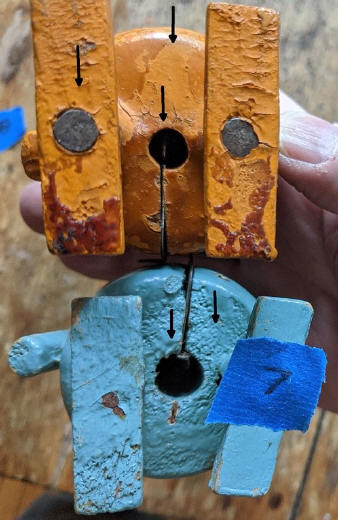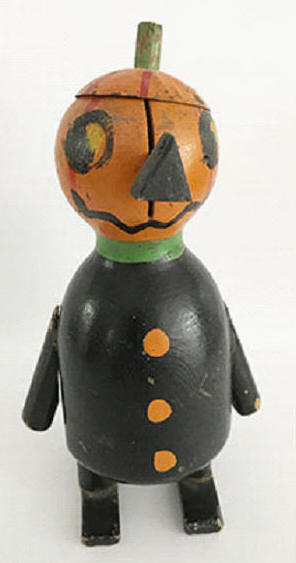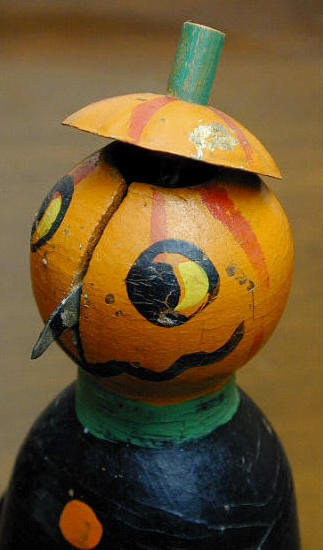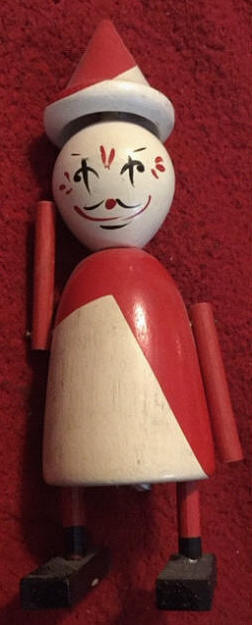|
SCAREY ANN LIST
Scarey Ann dolls were produced between 1923 and the early 1940s by
four companies: Poppy Doll Company, Atascadero Wood
Products, Atascadero Mill and Lumber Yard, and Poppy
Doll Company of Blue Rapids, Kansas. This list indicates the dolls
that were made by each company. It shows all the dolls that are known
to exist, either because examples have been found or because they
appear in advertising copy. Yet, undoubtedly, many other dolls were
also made which have not been found. Please contact me if you know of
other dolls, or if you have dolls to sell. Contact Gene Metcalf at:
metcalew@miamioh.edu
Photos below were contributed by:
Ron of antiquestoyscollectibles
Sandy Gast
Francie Owens
Joanne Cubbs
Kent Kenney
Richard Babcock
Landers Toys
Steve Mayo
Jim Sneed
|
|
POPPY DOLL COMPANY
Atascadero, California. Produced dolls between 1923-1930. |
|
Scarey Ann Girls
(Produced from 1923-1930.)

Advertisement from Toy Kraft
magazine, 1927
|
|
Early Composition Scarey Anns
Between late 1922 and early 1924 Scarey
Ann dolls were made of composite materials instead of the solid
redwood that was later used. In many ways these early dolls are
identical to the later wood dolls, however there are a few
differences. Unlike the later wooden dolls whose arms and legs were
attached to the body by small nails after the body was shaped, the
composition dolls were molded in two halves, front and back, with the
arms and legs attached to the body. Consequently, one can often see a
line where the front and rear halves are attached that goes up the
side of the doll. Finally, unlike the later dolls whose feet were
attached with two small wire brads, the feet of the composition dolls
were attached with one large, flat head nail that extended up the leg
into the body of the toy. (The pictures below were taken by Kevin
McGuire of toys from the collection of Francie Owens.)
|
 |
 |
 |
 |
 |
|
Scarey Ann Girls (regular
size) The most common Scarey Ann dolls. Five inches tall. Sold
with a paper cylinder around its head that trained the hair down. When
a lever in the back of the doll was pressed, the hair was pulled into
the head and stood up creating the appearance of fright. According to
a 1923 advertisement, "When you say ‘boo’ her hair stands on end by
pressing a lever." |
 |
|
Scarey Ann Girl
With hair standing up
|
 |
|
Scarey Ann Girl (large size)
One known. Probably a store display. 10 inches tall. Shown in
display cabinet at Atascadero Historical Society with two regular size
Chinese Scarey Ann dolls. |
 |
|
Scarey Ann Girl (small size)
One known. 2 inches tall. |

 |
|
Scarey Ann Mechanical Family
(The ten dolls below are the only ones for which specific names are
known since they were advertised together as a "Family." Produced by
the Poppy Doll Company between 1927-1930)

|
|
Ching Chang Lever operates queue on back of head and hat. |


 |
| |
 |
|
Clown Lever
operates hat and nose.
Many versions of these were made. |


 |
|
Ducky Daddle An Easter promotion. Lever in back operates hat and
wings that flap. No examples have been found. Pictured is a model of
the toy created from a newspaper advertisement by master woodworker
and toy maker Kevin McGuire for collector Steve Mayo. |
 |
|
Mule
Pushing tail down makes ears move. Two examples known. |
 |
|
Jack
Tar Lever operates hat and nose. |
 |
|
Pumpkin Head
A Halloween promotion. Lever operates nose
and top of pumpkin head. |

 |
|
Santa Claus A
Christmas promotion. Lever operates hat
and beard. |
 |
|
Scarey Hobo Lever operates nose and hat. Many versions made. |


 |
|
St. Patrick A St.
Patrick’s Day promotion. Pipe in mouth. Has shamrock in his
articulated right arm. Lever operates hat and right arm. Shown in
display cabinet at Atascadero Historical society. (This is one of only
two Scarey figures made with an articulated arm. The other was Duckey
Daddle that has two articulated wings that flap.) |
 |
|
Witch
A Halloween promotion. Different witches display a
variety of Halloween images on their chest: brooms, bats, cats, etc.
Lever operates hat and nose. |


 |
|
Miscellaneous Dolls
(Few advertisements or boxes are known for the following dolls.
Consequently, most of their names, with the exceptions of the
"Pilgrim" and "Picaninny" for whom an advertisement and box have been
found, are not known. Probably produced between late 1926 or 1927 and
1930, but after the Poppy Doll Company had first made the dolls in the
Scarey Ann Mechanical Family.) |
| Al
Smith Donkey In 1928 the Poppy Doll Company is
said to have produced an Al Smith Donkey
as a Democratic symbol for the November presidential election.
Presumably the donkey was created from the mule already in production.
No example has been found. |
NEED IMAGE |
|
Boy Scout
This is the only example known. Lever operates hat. |
 |
|
Chinese Man
Similar to Ching Chang, the Chinese doll introduced in the Scarey
Ann Mechanical Family, but with a different hat. A lever operated the
hat and a queue on the back of the head. This is the only example
known.
|

 |
|
Chinese Woman #1 Similar to other Scarey Ann girl dolls except
she has different eyes. Lever operates hair which stands up. This is the only example known.
|
 |
|
Chinese Woman #2 An
unusual version of this character in that the facial painting is quite
different than the other Poppy girls and the costume has no decorative
flowers or designs. |
 |
|
Clown
Unlike the clown produced in the Scarey Ann Mechanical Family which
has a conical hat and small nose, this version has a large, bulbous
nose and a mushroom shaped cap. Lever operates hat and nose. This is
the only example known. |
 |
|
Happy Hooligan Represents the popular cartoon figure. Lever
operates can on top of head. |
 |
Happy Hooligan
with Tin HatThis unusual Scarey Ann
is a Happy Hooligan with a tin "coolie" hat. Hat raises when the lever
on the back is pushed. The paint used on the hat is the same paint and
color as that on the body of the toy and the interior mechanism that
raises the hat is identical to that on other Scarey Anns. Because of
this, it is possible that the toy was not altered after it was
produced but was instead a factory production. |
 |
|
Hoover Elephant In 1928 the Poppy Doll Company is said to have produced a Hoover Elephant as a Republican symbol
for the November presidential election. The elephant’s trunk moved up
and down and its ears wagged when a lever was pushed. No example of
this figure has been found |
NEED IMAGE
|
|
Irishman Similar to St. Patrick except his arm is not
articulated. Lever operates hat. |
 |
Mickey Mouse
The most interesting Scarey Ann character,
probably produced by the Poppy Doll Company, remains at the center
of a mystery. In 1978 Michael Moore, the grandson of
Rew Troxell who worked at the Poppy
Company, wrote to the Atascadero Press claiming that in late 1928 or
early 1929 his grandfather traveled to Burbank, California, to meet
with Walt Disney, who had just released “Steamboat Willie,”
featuring the soon to be iconic “Mickey Mouse.” According to Moore’s
account, Troxell returned immediately to Atascadero where he
produced a Mickey Mouse prototype. However, although drawings and
models for this Mickey doll were said by Moore to be forthcoming,
they never arrived. Moreover the
prototype said to have been made by Troxell was later misplaced, and
Michael Moore has not been located.
A year later, in 1979, a box of Scarey Ann
parts and dolls was discovered on its way to the Central Coast
Landfill near Atascadero. In this box was a figure of Mickey Mouse.
The figure was taken to the Atascadero Historical Society and shown
to curator Marjorie Mackey. A picture of Ms. Mackey holding the
Mickey figure, as well as a large Scarey Ann store display, appeared
in the Atascadero News in 1979.

Marjorie Mackey and Mickey Mouse
Yet the Mickey doll found in the box with
Scarey Ann parts and pictured with Marjorie Mackey was not unknown.
Called a Borgfeldt Mickey, since Disney signed an early contract
with the George Borgfeldt Company as the sole licensee and
distributor for Mickey and Minnie Mouse toys, this doll is thought
by collectors to be the first Mickey Mouse doll. Yet
Borgfelldt did not manufacture the toys
they distributed, and they did not become Disney’s distributor until
1930, after the tag attached to the front of the Borgfeldt Mickey says the patent
was applied for. (The decal reads, “Pat Applied for: 1928-1930 by
Walter E. Disney.”) In addition, during this period the
Poppey Doll Company produced a number of
unlicensed toys based on popular culture and cartoon characters like
Happy Hooligan and Duckey
Daddle, and this Mickey is remarkably
similar to other toys they were making. The same size as the other
dolls produced by Poppy Company, the Mickey doll also features the
same interior mechanism which animates the other Scarey Ann dolls.
This mechanism moves Mickey’s head up and down when a tab,
which is identical to those on other Scarey dolls and to which Mickey's tail is
attached, is pushed.
The maker of the Borgfeldt Mickey has never
been identified. It was probably manufactured in 1929 by the Poppy
Doll Company.


The Borgfeldt Mickey
|
|
Picaninny Many of these were made. They came in a variety of
costumes, colors and versions. Most had black hair, but a few had red
hair. Lever in back
operates hair which goes up and down. |

 |
|
Picaninny Black Farmer
Unusual and rare version. Dressed in
overalls. Expressive face with eyelashes. |
 |
|
Picaninny with Bolo Tie and
Picaninny box The Picaninny is one of only two Scarey
characters, not in the Scarey Family, whose name is known because a
box has been found. |

 |
|
Picaninny Advertising Figure
Scarey Ann dolls were often used for advertising. This doll was
used by the owner of a grain storage business in Kansas. The sticker
on the doll sought to allay farmers’ concerns about the prices they
might receive for their crops in a precarious market. It read: "Not
Scared When Consigned to George E. Gano." This is the only example known. |

 |
|
Pilgrim A Thanksgiving
promotion. Very similar to the Scarey Hobo except that he is always
dressed in a black suit and does not have a scruffy beard. Advertising
illustration from 1927 advertisement. This is one of only three Scarey
Ann dolls, not included in the Scarey Ann Family, whose name is known
due to this advertisement. Lever operates hat and nose. |

 |
|
Policeman Lever in back
operates hat. This is the only example known. |
 |
|
Professor Lever in back moves beard and hat up and down |
 |
|
Sailor Unlike Jack Tar, which was produced as a part of the
"Scarey Ann Mechanical Family," this sailor has a flat hat. Lever
operates hat and nose. |

 |
|
Prototypes
(The following toys were never put into
production by the Poppy Doll Company.) |
|
Large Scarey Ann (on right)
Over 7 inches tall, this doll has
painted hair and no arms, or interior mechanism to raise the hair if
it had any .
Probably a prototype. |
 |
|
Scarey Ann on a
Platform This object was purchased on Ebay in 2019. It consists
of a Scarey Ann doll attached to flat eight-sided, stand. Since the
paint on the stand is identical to that on the doll, it must be
assumed that the two were made together. This is the ONLY example of a
Scarey Ann doll where both
the arms mechanically raise up in conjunction with the hair raising
via the lever on the back. |

 |
|
Atascadero Wood Products Company.
(When the Poppy Doll Company went out of business in 1930, the patent
rights to Scarey Ann dolls were purchased by the Atascadero Wood
Products Company. The dolls made by Atascadero Wood Products were
similar to the dolls produced by the Poppy Doll Company except that
the arms, legs and feet
were painted separately from the body, and they are often painted in a
different color from the body. These dolls
were produced between 1930-1932.) |
|
Scarey Ann
Only one doll made by Atascadero Wood Products has been found. The
legs, arms, and feet, colored red and black, were painted separately
from the body and then attached to the body after it had been painted.
Lever in the back operates the hair. |
 |
|
|
Atascadero Mill and Lumber Yard The Atascadero Mill and Lumber Yard
purchased the Scarey Ann patent rights in 1933, on the demise of the
Atascadero Wood Products Company. The dolls made by Atascadero Mill
were slightly different than the dolls made by the Poppy Company, in
that they had swinging arms attached to the body by a single nail,
longer and narrower legs, and their interior mechanisms were simpler,
enabling the head of each doll to move up and down on a wooden dowel. Also, instead of being
hand painted, most of them were painted with stencils. These dolls
were likely produced between 1933-1939.)

Advertisement for Atascadero Mill and
Lumber Yard, January 20, 1933
|
Baby
Possibly based on a common cartoon presentation of a baby with googly
eyes and one curly hair on the top of the head, as in the "picky
eater" comic.) We do not know why there is an unpainted circle on the
front of the baby's face. Any ideas? The head raises on a dowel and
the arms are attached to the side with a nail and swing. This is the
only example known, |

 |
Man in Brown Suit
Has tones of red and green on his brown hat. The head raises on a
dowel and the arms are attached to the side with a nail and swing.
This is the only example known. |
 |
|
Chinaman #1 The Chinaman, as all the
other toys made by the Atascadero Mill and Lumber Yard, were
simplified versions of the dolls that had been produced by Poppy Doll
Company. Instead of a spring mechanism to raise the hair or hats of
the doll these dolls had a dowel which raised the head up off the
shoulders of the figure. Also swinging arms, each attached by one
nail.
Two examples known. |

 |
|
Chinaman #2 An unusual version of this
Atascadero Mill character in that it does not have swinging arms, but
rather stationary arms that stick out horizontally from the body. This is the only example
known. |
 |
|
Clown
Head raises on a dowel. Arms attached with a nail and swing.
Four examples known. |

 |
|
Grandfather Has a hair goatee attached
to his chin. Head raises on a dowel. Arms attached with a nail and
swing.
Two examples known. |

 |
|
Grandmother
Presumably made to be a partner to the Grandfather. Head raises on a
dowel. Arms attached with a nail and swing.
Two examples known. |
 |
Irish Man
A very unusual toy in that all the other Scarey Anns from the
Atascadero Mill and Lumber Yard have round heads which required
little, if any, hand work. The head on this toy was probably
hand-fashioned. Otherwise similar to the other Mill and Lumber Yard
examples in that the head raises on a dowel and the arms are attached
to the side with a nail and swing. This is the only example known. |
 |
|
Policeman The buttons and belt appear to
be done with a stencil. Head raises on a dowel. Arms attached with a
nail and swing.
Two examples known. |
 |
Man with
Chin Whiskers
The chin whiskers on this toy are similar to those on the Grandfather
except that while the Grandfather has one whisker (a goatee) coming
from his chin this toy has two, one protruding from each side of his
mouth. Head raises on a dowel and the arms are attached with a nail
and swing. This is the only example known. |
 |
| |
|
|
Porter The paint stripes on the front of the suit as well as the
facial features appear to be done with a stencil. Head raises on a
dowel. Arms attached with a nail and swing. There are two examples
known. |
 |
Sailor
Head raises on a dowel and the arms are attached with a nail and
swing. This is the only example known. |
 |
|
Hobo This figure was probably made by the
Atascadero Mill and Lumber Yard since it has legs and feet that are
similar to those of other dolls made by this maker and, like them, its
head raises on a dowel. However, its arms appear fixed and do not
swing like other Atascadero Mill dolls. This is the only example
known. |
 |
|
Poppy Doll Company, Blue
Rapids, Kansas .
(The dolls made in Kansas are identical to the ones first made in
Atascadero by the Poppy Doll Company, except that their eyes are
larger and instead of
having a dot painted on the front of each leg like the dolls made by
in Atascadero these dolls have a dot painted on the front of each
foot. It is likely that they were made by
members of Dr Chin’s family who lived in Blue Rapids. Chinn, who
developed the Scarey Ann doll in Atascadero, California, is known to
have visited Blue Rapids often in the late 1930s and early
1940s. These dolls were produced in the early 1940s.) |
| Scarey Ann
Girl |
 |